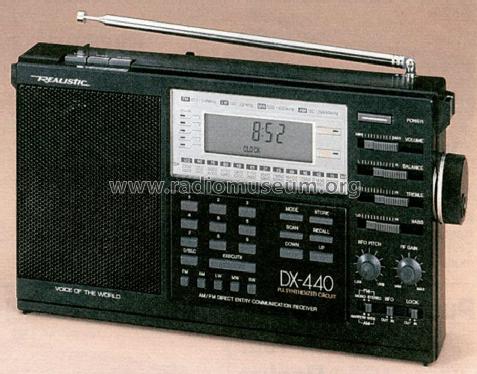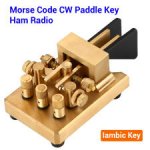You are using an out of date browser. It may not display this or other websites correctly.
You should upgrade or use an alternative browser.
You should upgrade or use an alternative browser.
CW
- Thread starter JAF27
- Start date
- Status
- Not open for further replies.
majoco
Stirrer
Coast stations for shipping are still around. Try Haifa ....https://mt-milcom.blogspot.com/2012/11/israeli-hf-military-frequencies.html...or plenty of Chinese stations XSG, XSQ....especially in the 8Mhz band in the Chinese evening - all sending their ident in CW.
To the OP I'd recommend finding a used Realistic DX-440 (Sangean ATS-803A) portable communications receiver. It has a BFO. You can usually find them for around $100 or less. In my mind it was one of the best in it's class. I had one for many years and wish I had never got rid of it.


Lots of CW on the 30 meter band too (10.130-10.150 Mhz). Also narrow band digital... That's all that's allowed there.. no SSB.
All this talk about CW has me and my son wanting to learn. I've read that having a practice oscillator that we can use to "send" to each other helps. I'd like to practice on an iambic paddle, as I can see me using that long term.
There are two theories of learning/sending CW. The first: The American Radio Relay League (ARRL) send the individual characters quickly, and the over-all speed is determined by the spacing between the characters. The second approach (the one I agree with) says there's a certain ratio between dots ("dit"), dashes ("dah"), and spaces, and all three determine the speed of the CW being sent. The reason I like this better (and it's the predominant use on the air) is because it sets a certain rhythm or cadence making it easier to hear (I think Wikipedia may explain it better than I can). Back in the day when everything came on LP records, a company called Ameco made a two-LP learning set that used the second approach.
As for sending method, many people start off with a straight key (there's nothing wrong with that), and upgrade to a keyer later. It's whatever you're most comfortable with. There are plenty out there already built (some radios have them installed), as well as stand-alone and DIY.
To the OP I'd recommend finding a used Realistic DX-440 (Sangean ATS-803A) portable communications receiver. It has a BFO. You can usually find them for around $100 or less. In my mind it was one of the best in it's class. I had one for many years and wish I had never got rid of it.
The Sony ICF-2001 and ICF-2010 were also pretty good, back in their day.
majoco
Stirrer
Waaay back in the 60's when I was in training to be a Marine Radio Officer, our instructor said that we are not to touch a key until we could receive at 12 wpm and don't listen to your own sending as it will sound 'perfect'.
Waaay back in the 60's when I was in training to be a Marine Radio Officer, our instructor said that we are not to touch a key until we could receive at 12 wpm and don't listen to your own sending as it will sound 'perfect'.
I remember working a few ex-military ops on CW--best sounding fists on the air!
danesgs
Member
Belvdr,
While true that most CW is in the HAM bands, one way to practice decoding CW is listening to non-directional beacons or NDB's in the LW range below the AM broadcast band. This also requires a radio that has CW/SSB and can tune that low. Many Tecsun higher end radios like the PL-600 or 660 models will tune what you want and can be found at under 100.00. I learned a little CW listening to beacons as they are 3 digit CW ID's that repeat over and over. Used mostly for outer marker beacons for airports. These may disappear as well with time and can be hard to hear during the summer months due to static but still fun to ID anyway. You can find code practice oscillators on Ebay for 10 bucks in kit form.
While true that most CW is in the HAM bands, one way to practice decoding CW is listening to non-directional beacons or NDB's in the LW range below the AM broadcast band. This also requires a radio that has CW/SSB and can tune that low. Many Tecsun higher end radios like the PL-600 or 660 models will tune what you want and can be found at under 100.00. I learned a little CW listening to beacons as they are 3 digit CW ID's that repeat over and over. Used mostly for outer marker beacons for airports. These may disappear as well with time and can be hard to hear during the summer months due to static but still fun to ID anyway. You can find code practice oscillators on Ebay for 10 bucks in kit form.
The NDBs here are all in AM mode, sending the code as modulated CW, so that SSB is not required to hear them.Belvdr,
While true that most CW is in the HAM bands, one way to practice decoding CW is listening to non-directional beacons or NDB's in the LW range below the AM broadcast band. This also requires a radio that has CW/SSB and can tune that low. Many Tecsun higher end radios like the PL-600 or 660 models will tune what you want and can be found at under 100.00. I learned a little CW listening to beacons as they are 3 digit CW ID's that repeat over and over. Used mostly for outer marker beacons for airports. These may disappear as well with time and can be hard to hear during the summer months due to static but still fun to ID anyway. You can find code practice oscillators on Ebay for 10 bucks in kit form.
belvdr
No longer interested in living
- Joined
- Aug 2, 2013
- Messages
- 2,567
All NDBs are that way, at least in the US.The NDBs here are all in AM mode, sending the code as modulated CW, so that SSB is not required to hear them.
The only difference I'm aware of is that Canadian NDBs send a long dash after their IDs. The first time I heard one was when I lived in Vancouver. Every time I heard the signal I decoded it as VRT, when in fact is was just VR, followed by the characteristic long dash. Vancouver Airport's code is YVR, or CYVR in full. The three or four NDBs I can hear at my present location all send that long dash.
Some CW can sound very musical. When Vancouver's coastal station, VAI, was still on the air listening to their repeated ident was almost hypnotic. I can still hear that rhythm in my head, and could probably write an entire melody based on it. Maybe someday I will.The second approach (the one I agree with) says there's a certain ratio between dots ("dit"), dashes ("dah"), and spaces, and all three determine the speed of the CW being sent. The reason I like this better (and it's the predominant use on the air) is because it sets a certain rhythm or cadence making it easier to hear (I think Wikipedia may explain it better than I can).
Belvdr,
While true that most CW is in the HAM bands, one way to practice decoding CW is listening to non-directional beacons or NDB's in the LW range below the AM broadcast band. This also requires a radio that has CW/SSB and can tune that low. Many Tecsun higher end radios like the PL-600 or 660 models will tune what you want and can be found at under 100.00. I learned a little CW listening to beacons as they are 3 digit CW ID's that repeat over and over. Used mostly for outer marker beacons for airports. These may disappear as well with time and can be hard to hear during the summer months due to static but still fun to ID anyway. You can find code practice oscillators on Ebay for 10 bucks in kit form.
There are also airport beacons, but I forgot their freqs...
belvdr
No longer interested in living
- Joined
- Aug 2, 2013
- Messages
- 2,567
What kind of airport beacons? That’s a new one on me.There are also airport beacons, but I forgot their freqs...
What kind of airport beacons? That’s a new one on me.
Navigation beacons--they usually send out a three-letter identification aircraft use to home-in on. The three letter identifiers are mentioned in one of the references pilots carry with them. For example, a local one we have around here is "OBK" which is in Northbrook, IL. (That's the only one I have memorized...)
belvdr
No longer interested in living
- Joined
- Aug 2, 2013
- Messages
- 2,567
Do you mean VORs or NDBs? I've never heard of a beacon for an airport.Navigation beacons--they usually send out a three-letter identification aircraft use to home-in on. The three letter identifiers are mentioned in one of the references pilots carry with them. For example, a local one we have around here is "OBK" which is in Northbrook, IL. (That's the only one I have memorized...)
EDIT: I looked it up and it's a VOR in that case. Airports themselves don't have a beacon, except for marker beacons and localizers.
That's the same mistake I made earlier in this thread by using the wrong acronym. My local airport transmits a localizer signal using the same airport ID sent by the NDB about a mile or so away. I don't think I've heard the VOR, at least I haven't discovered its frequency.Do you mean VORs or NDBs? I've never heard of a beacon for an airport.
EDIT: I looked it up and it's a VOR in that case. Airports themselves don't have a beacon, except for marker beacons and localizers.
belvdr
No longer interested in living
- Joined
- Aug 2, 2013
- Messages
- 2,567
Which airport? I can check the sectional if you like. There may not be any VORs near the airport in question.That's the same mistake I made earlier in this thread by using the wrong acronym. My local airport transmits a localizer signal using the same airport ID sent by the NDB about a mile or so away. I don't think I've heard the VOR, at least I haven't discovered its frequency.
Never mind! You're right, there aren't any near our airport. I found the VOR's listing on AirNav's website. It's at a different airport, which is too far away from ours, and there are high mountains between us, so my scanner can't pick it up at all. At any rate, it's on the VHF air band at 113.90 Mhz, and would be sending the other airport's ident.Which airport? I can check the sectional if you like. There may not be any VORs near the airport in question.
Last edited:
- Status
- Not open for further replies.
Similar threads
- Replies
- 1
- Views
- 276
- Replies
- 12
- Views
- 398




